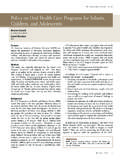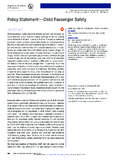Transcription of Policy on Dietary Recommendations for Infants, …
1 56 ORAL HEALTH POLICIESREFERENCE MANUAL V 37 / NO 6 15 / 16 Originating Committee Clinical Affairs CommitteeReview CouncilCouncil on Clinical AffairsAdopted 1993 Revised 1999, 2002, 2005, 2006, 2008, 2012 PurposeThe American Academy of Pediatric Dentistry (AAPD) recog-nizes its role in promoting well-balanced, low caries-risk, and nutrient-dense diets for infants, children, adolescents, and persons with special health care The revision of this Policy is based on a review of current dental and medical literature related to diet and nutrition for infants, children, and adolescents. This document is an update of the previous version, revised in 2008.
2 The update included an electronic PubMed search combining terms such as caries and body mass index, breast-feeding, diabetes, hypertension, physical activity, nutrition, obesity, sugar-sweetened beverages, sugar-sweetened medications, sugar-containing medications, chewable vitamins, and sugar-sweetened vitamin supplements and relevant articles from dental and medical literature. The search returned 3,755 articles. The reviewers agreed upon the inclusion of 36 articles that met the defined criteria. Relevant policies and guidelines of the AAPD, the American Academy of Pediatrics (AAP), US Department of Agriculture (USDA), Department of Health and Human Services (DHHS), and Academy of Nutrition and Dietetics also are Establishment of a dental home by 12 months of age allows the institution of individualized caries-preventive strategies, including Dietary Recommendations and appropriate oral hy- giene instruction, as the primary teeth begin to Dietary choices affect oral health as well as general health and well- being.
3 Epidemiological research shows that human milk and breast-feeding of infants provide general health, nutritional, developmental, psychological, social, economic, and environ-mental advantages while significantly decreasing risk for a large number of acute and chronic Human breast milk is uniquely superior in providing the best possible nutrition to infants and has not been epidemiologically associated with Frequent night time bottle-feeding with milk is asso- ciated with, but not consistently implicated in, early childhood caries (ECC).6 Breastfeeding greater than or equal to seven times daily after 12 months of age is associated with increased risk for Ad libitum breastfeeding after introduction of other Dietary carbohydrates and inadequte oral hygiene are risk factors for ECC.
4 The AAP has recommended children one through six years of age consume no more than four to six ounces of fruit juice per day, from a cup (ie, not a bottle or covered cup) and as part of a meal or Night time bottle-feeding with juice, repeated use of a sippy or no-spill cup, and frequent in be- tween meal consumption of sugar-containing snacks or drinks (eg, juice, formula, soda) increase the risk of ,9 ECC can be a particularly aggressive form of caries, be- ginning soon after tooth eruption, developing on smooth surfaces, progressing rapidly, and having a lasting detrimental impact on the Consequences of this disease may lead to more widespread health Caries and its sequelae are among the most prevalent health problems facing American infants, children, and adoles-cents.
5 Frequent ingestion of sugars and other carbohydrates (eg, fruit juices, acidic beverages) and prolonged contact of these substances with teeth are particular risk factors in the development of caries. Along with increasing caries risk, in- creased consumption of sugar-sweetened beverages and snack foods also has been linked to ,16 Childhood over- weight and obesity have reached epidemic proportions worldwide, and the prevalence among US youth has quadrupled in children ages six to 11 and nearly doubled in adolescents ages 12 to 19 in the past 25 Results from a study 2007-2008 that measured height and weight estimated percent of children and adolescents in the US aged two through 19 were Differences were seen in estimates among ethnic groups.
6 Ranging from the lowest ( percent) among non-Hispanic white girls to the highest Policy on Dietary Recommendations for Infants, Children, and Adolescents AMERICAN ACADEMY OF PEDIATRIC DENTISTRY ORAL HEALTH POLICIES 57( percent) among Mexican-American Health risks associated with childhood overweight and obesity are strong indicators for predisposition to adult morbidity and mortality and include type II diabetes, cardiovascular disease (hyper- tension, hypercholesterolemia, and dyslipidemia), and psychological stress (depression and low self-esteem), as well as respiratory (obstructive sleep apnea and asthma), orthopedic (genu varum and slipped capital femoral epiphysis), and hepatic (steatohepatitis)
7 Although studies are limited in the pediatric population, one study indicated that adolescents aged 17 to 21 years had an increased risk of periodontal disease for each one kg in- crease in body weight and one cm increase in waist circum- Incipient periodontal disease has been found to be increased in children and adolescents with Excessive consumption of fruit juice has been associated with small stature in some It has been shown that nearly 54 percent of US preschool children were given some form of over-the-counter (OTC) medications, most commonly as analgesics, antipyretics, and cough and cold Numerous OTC and prescribed oral liquid medications have been found to have a high sugar content to increase palata- bility and acceptance by Frequent ingestion of sugar-sweetened medications has demonstrated a higher incidence of caries in chronically ill ,25,27-29 To motivate children to consume vitamins, numerous companies have made jelly, gummy.
8 And candy-like chewable vitamin Cases of vitamin A toxicity have been reported as a result of excessive consumption of candy-like vitamin The AAP has recommended that the optimal way to obtain adequate amounts of vitamins is to consume a healthy and well-balanced help the public make choices for a healthy diet, the USDA and DHHS published Dietary Guidelines for Ameri- ,32 These guidelines include: Eating a variety of nutrient-dense foods and beverages. Balancing foods eaten with physical activity to maintain a healthy body mass index. Maintaining a caloric intake adequate to support normal growth and development and to reach or maintain a healthy weight.
9 Choosing a diet with plenty of vegetables, fruits, and whole grains and low in fat, saturated (especially trans-saturated) fat, and cholesterol. Using sugars and salt (sodium) in ,32 Food companies can encourage food and beverage selec- tions that contribute to healthier lifestyles by increasing the prominence, simplicity, and uniformity of nutritional informa- tion on food packaging statement The AAPD, in its efforts to promote optimal health for infants, children, and adolescents, supports the position of the Acad- emy of Nutrition and Dietetics that all children should have access to healthy food and nutrition programs that ensure the availability of a safe and adequate food supply that promotes optimal physical, cognitive, and social growth and The AAPD encourages.
10 Breast-feeding of infants to ensure the best possible health and developmental and psychosocial outcomes, with care to wiping or brushing as the first primary tooth begins to erupt and other Dietary carbohydrates are introduced. Educating the public about the association between fre- quent consumption of carbohydrates and caries. Educating the public about other health risks associated with excess consumption of simple carbohydrates, fat, saturated fat, and , the AAPD encourages: Pediatric dentists and other health care providers who treat children to provide Dietary and nutrition counseling (commensurate with their training and experience) in conjunction with other preventive services for their patients.
















